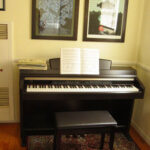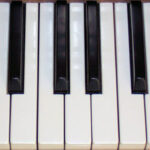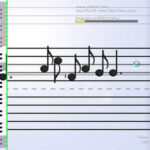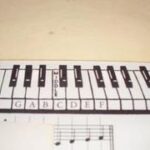The first thing you need to know is where the notes are, and the tones. On most pianos and keyboards there are 61 keys. Each key is a sequence of several notes. These notes are like the first seven letters of the alphabet which are: ABCDEFG. Each of these letters have a series of several tones that lead to a tone similar to the first. This makes these notes a scale of eight notes. If one were to use numbers it would be written as 12345671. Each notes represents a key to which a scale follows as a succession of tone sounds.
A scale like this where there is a note on bottom and a similar one on top is an Octave. These ivory white keys on the piano are in this order. The black ivory keys of the piano is in a sequence of two’s and three keys. These notes function as additions to the scale of those notes mentioned above. Moreover, these keys can lower a key one half step of raise it one half step. To lower a key one half step is known as a flat(b). To raise a key one half step is a sharp(#). On the piano you will find that two black keys are placed above the CDE white keys. The first of these black keys can be a C# (sharp) or Db(flat).
The next three black keys are over the FGAB notes. The first of these keys can become a F# or Gb. The next black key can become a G# or Ab. The last of the three black keys can be either an A# or Bb. Now you know how the piano looks and where to find the keys. In order to be able to play you must use your ears to listen to each sound. You should make sure that each key you play has tones that sound in a chronological order. Meaning, each key must sound as if it is climbing up steps. This is why it is important that you use your ears. If the scale begins like stairs, each tone should to equal to the other. Each tone is meant to rise in order to reach the top, but not leave you stranded.
It is easy to play the wrong notes when you are unfamiliar with music performance. Fortunately, you can recover from wrong notes by feeling out for the right ones. Once you do this for the first few scales, you will know how to play the others. Next, you must know how to read music written for piano. There is a long rectangular box with five lines, a word, a couple numbers, a symbol of some kind and dots with a stem. The rectangular box is a measure of music. The five lines are the ledger lines which represents basic notes. The word above the box describes the tempo style of the music.The numbers are the meter or time signature that tells us the rhythm content of the music. The symbol before the numbers tells us what clef one is in. In most sheet music, the top line is the treble or G clef. The order from bottom to top are: EGBDF for lines and FACE for spaces.
The bottom line that looks like a curved seven is the bass or F clef. The order from bottom to top are: GBDFA for lines and ACEG for spaces. There are other clefs that work with certain music instruments like the C clef or Alto Clef in which the symbol is in the center of the ledger lines.The dot with a stem is a note. Each note has it’s own value: a quarter note is a darkened oval with a stem that represents one beat. The half note is an empty oval with a stem that represents to beats. The dotted half note looks the same, but with a dot at the end representing three beats. A total oval without a stem is a whole note representing four beats. An 8th note is a note like the quarter note with a flag at the end of the stem. Two of these notes equal one beat, so it will have to be played slightly quicker. An 16th note is like the 8th note, yet with two flags.
Four of these notes equal the quarter note, but two represents the 8th note. This will have to be played quicker than the 8th note. There are breaks in music between these notes that are known as rests. There are also hyphens between the words or lyrics of a piece to indicate the same intention. The symbol of a the zigzag of lightening is the quarter rest. The symbol of a darkened line above a rectangular shaded box is a half rest. The symbol of a darkened line below a shaded rectangular shaded box is a whole rest. The dotted half rest looks the same as the half rest with a dot. There are also dotted quarter notes with a dot after it. The dot extends the length of time which you hold the key down one half beat longer. The 8th rest looks kind of like a thin bass clef symbol. You have one more thing to learn before playing piano. Each succession of tones in a key has a certain number of sharps or flats in the scale. As you play each scale ascending from A to G you will find the black keys. Scales ascending using black key are raising tones making certain ones sharps. Scales descending using black keys are lowering tones to make flats. On sheet music, sharps and flats are sketched on the ledger lines and spaces to indicate the key. This is called a key signature.
The order in which sharps are written is: F#, C#, G#,D#,A#,E# and B#. The order in which flats are written is: Bb, Eb, Ab, Db, Gb,Cb and Fb. The keys are in this order:
Key SharpsFlats
C 0 0
C# 7(FCGDAEB) 0
D 2 (FC) 0
E 4(FCGD) 0
F 0 1(B)
F# 6(FCGDAE) 0
G 1(F) 0
A 3(FCG) 0
B 5(FCGDA) 0
Bb 0 2(BE)
Cb 0 7(BEADGCB)
Db 0 5(BEADG)
Eb 0 3(BEA)
F 0 1(B)
Gb 0 6(BEADGC0
Ab 0 4(BEAD)






